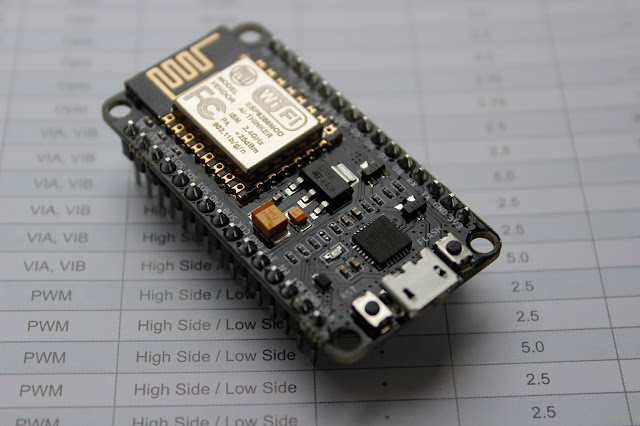The ESP8266 is an amazing chip for all your home automation & Internet of Things projects. This chip costs less than $5, has WiFi connectivity, an onboard processor, and is compatible with the Arduino IDE. I already wrote a guide on how to get started with the ESP8266, but I wanted to dive deeper and answer a fundamental question: how to choose your ESP8266 module?
Indeed, there are many choices available on the market, and it is easy to get lost between all of them. This is why I wrote this guide to help you out choosing your ESP8266 module for your next project. This list is of course non-exhaustive, but these all are modules I tested myself and I was satisfied with. Let’s dive in!
:
Dimension:
Length*width*Height:14.3*24.8*3mm
PAD Size(Bottom):0.9*1.7mm
Pin Pitch:2.54mm
The first module of this guide, which is one of the first ESP8266 modules that came out on the market, is the ESP-01 module. It is the cheapest and nearly the smallest module available. It is perfectly usable with the Arduino IDE for example.
However, it comes with serious disadvantages. First, you can’t plug it into a breadboard without an adapter. Then, you don’t have access to all the input/output pins of the ESP8266 chip, which is a problem if you have complex projects that you want to build. However, for simple projects, this is a good module to start with.
The next one I wanted to mention in this list is the ESP-07, which is the one you see on the right on the picture. This module can’t be used alone on a breadboard, as you need an adapter board (usually sold with the module) to use it in your breadboard projects. It is actually the base of several other ESP8266 modules, as we will see later in this guide.
The advantage of this module is that it’s quite easy to integrate on a PCB later on, so if you plan to develop your own ESP8266 home automation projects in the future, that might be the ideal solution for you.

Add Internet to your next project with an adorable, bite-sized WiFi microcontroller, at a price you like! The ESP8266 processor from Espressif is an 80 MHz microcontroller with a full WiFi front-end (both as client and access point) and TCP/IP stack with DNS support as well. We do sell these on a breakout, but maybe you wanna just put this in your own project PCB.
As of Sept 3rd, we are shipping the AI-thinker ESP-12E version which has the SPI flash pads brought out on the bottom row. Note that you cannot use them for GPIOs or anything, they're there so you can program the FLASH chip only.
These modules are very easy to hand solder, with big pads! We have this part in the Adafruit Eagle library (Ai-thinker ESP12) - the extra pads don't appear but they are not usable anyways.
Comes with 4MB flash chip, ESP processory, and onboard antenna. These come pre-progammed with the NodeMCU Lua firmware, so you are ready to rock. Some extra parts will be needed to get this going, check out the HUZZAH schematic for the extra components we recommend
For advanced users only! This product is just the module - which can be difficult to use. Click here if you're looking for the Huzzah ESP8266 Breakout!
Product Feature:
• 802.11 b/g/n
• Integrated low power 32-bit MCU
• Integrated 10-bit ADC
• Integrated TCP/IP protocol stack
• Integrated TR switch, balun, LNA, power amplifier and matching network
• Integrated PLL, regulators, and power management units
• Supports antenna diversity
• Wi-Fi 2.4 GHz, support WPA/WPA2
• Support STA/AP/STA+AP operation modes
• Support Smart Link Function for both Android and iOS devices
• Support Smart Link Function for both Android and iOS devices
• SDIO 2.0, (H) SPI, UART, I2C, I2S, IRDA, PWM,GPIO
• STBC, 1x1 MIMO, 2x1 MIMO
• A-MPDU & A-MSDU aggregation and 0.4s guard interval
• Deep sleep power <10uA, Power down leakage current < 5uA
• Wake up and transmit packets in < 2ms
• Standby power consumption of < 1.0mW (DTIM3)
• +20dBm output power in 802.11b mode
• Operating temperature range -40C ~ 125C
Dimension:
Length*width*Height:16*24*3mm
PAD Size(Bottom):0.9*1.7mm
Pin Pitch:2mm
So Which Module Should You Get?
Of course, the answer depends on what you want to do with your ESP8266 module. If your goal is to experiment with your ESP8266 on a breadboard, then I really recommend the the AI-thinker ESP8266 module.
If your plan is to integrate your ESP8266 on your own PCB in the future, then I can only recommend to use the ESP-07 module + an adapter breakout board.
more info: nicole@aithinker.com









没有评论:
发表评论